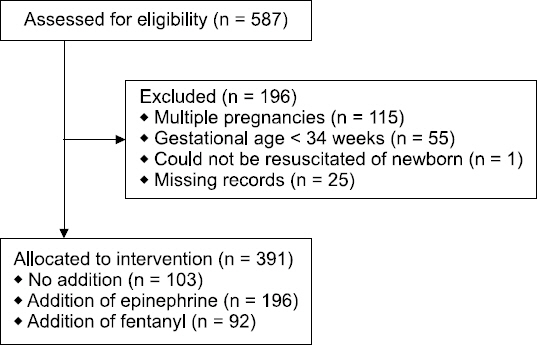Anesth Pain Med.
2017 Jul;12(3):233-239. 10.17085/apm.2017.12.3.233.
Beneficial effects of the addition of intrathecal fentanyl to bupivacaine for spinal anesthesia in cesarean section
- Affiliations
-
- 1Department of Anesthesiology and Pain Medicine, Jeju National University School of Medicine, Jeju, Korea. pjcook@jejunu.ac.kr
- 2Department of Emergency Medicine, Jeju National University School of Medicine, Jeju, Korea.
- KMID: 2388838
- DOI: http://doi.org/10.17085/apm.2017.12.3.233
Abstract
- BACKGROUND
The addition of fentanyl or epinephrine to bupivacaine enhances the quality of intraoperative spinal anesthesia during cesarean section. This study aimed to evaluate the beneficial effects of adding fentanyl or epinephrine to bupivacaine in spinal anesthesia solutions used for patients undergoing cesarean section.
METHODS
This retrospective study included 391 patients who underwent cesarean section under spinal anesthesia between March 2009 and February 2014. Parturients were categorized into group N (no addition; n = 103), group E (addition of epinephrine; n = 196), and group F (addition of fentanyl; n = 92). Perioperative hemodynamic changes, complications, sensory recovery times, Apgar scores, and cord blood pH were analyzed.
RESULTS
Nausea and vomiting occurred more frequently in group E than in the other two groups (P < 0.001 and P = 0.027, respectively). The mean sensory recovery times to T10 level showed statistically significant intergroup differences (P < 0.001). Group F showed the highest 1-min and 5-min Apgar scores, with statistically significant differences amongst the three groups (P = 0.007 and P < 0.001, respectively). However, the blood gas analysis variables of the cord blood did not show significant differences.
CONCLUSIONS
Addition of fentanyl to bupivacaine was related to a longer sensory recovery time than did the addition of nothing or epinephrine. Moreover, it had been associated with beneficial effects such as a reduction in complications following spinal anesthesia.
Keyword
MeSH Terms
Figure
Reference
-
1. BirBach DJ, Browne IM. Anesthesia for obstetrics. Miller’s Anesthesia. 7th ed. Miller RD, editor. Philadelphia: Churchill Livingston;2010. p. 2203–40.2. Block A, Covino BG. Effect of local anesthetic agents on cardiac conduction and contractility. Reg Anesth Pain Med. 1981; 6:55–61.3. Abouleish EI. Epinephrine improves the quality of spinal hyperbaric bupivacaine for cesarean section. Anesth Analg. 1987; 66:395–400. DOI: 10.1213/00000539-198705000-00004. PMID: 3555162.4. Abouleish E, Rawal N, Rashad MN. The addition of 0.2 mg subarachnoid morphine to hyperbaric bupivacaine for cesarean delivery: a prospective study of 856 cases. Reg Anesth. 1991; 16:137–40. PMID: 1883770.5. Hunt CO, Naulty JS, Bader AM, Hauch MA, Vartikar JV, Datta S, et al. Perioperative analgesia with subarachnoid fentanyl- bupivacaine for cesarean delivery. Anesthesiology. 1989; 71:535–40. DOI: 10.1097/00000542-198910000-00009. PMID: 2679237.6. Weigl W, Bieryło A, Krzemień-Wiczyńska S, Mayzner-Zawadzka E. Comparative study of postoperative analgesia after intrathecal administration of bupivacaine with fentanyl or morphine for elective Caesarean section. Anestezjol Intens Ter. 2009; 41:28–32. PMID: 19517674.7. Abboud TK, Dror A, Mosaad P, Zhu J, Mantilla M, Swart F, et al. Mini-dose intrathecal morphine for the relief of post-cesarean section pain: safety, efficacy, and ventilatory responses to carbon dioxide. Anesth Analg. 1988; 67:137–43. DOI: 10.1213/00000539-198802000-00006. PMID: 3277478.8. Chadwick HS, Ready LB. Intrathecal and epidural morphine sulfate for post-cesarean analgesia--a clinical comparison. Anesthesiology. 1988; 68:925–9. DOI: 10.1097/00000542-198806000-00015.9. Abouleish E, Rawal N, Tobon-Randall B, Rivera-Weiss M, Meyer B, Wu A, et al. A clinical and laboratory study to compare the addition of 0.2 mg of morphine, 0.2 mg of epinephrine, or their combination to hyperbaric bupivacaine for spinal anesthesia in cesarean section. Anesth Analg. 1993; 77:457–62. DOI: 10.1213/00000539-199309000-00007. PMID: 8368545.10. Denson DD, Bridenbaugh PO, Turner PA, Phero JC, Raj PP. Neural blockade and pharmacokinetics following subarachnoid lidocaine in the rhesus monkey I. Effects of epinephrine. Anesth Analg. 1982; 61:746–50. DOI: 10.1213/00000539-198209000-00006. PMID: 6896608.11. Yu SC, Ngan Kee WD, Kwan AS. Addition of meperidine to bupivacaine for spinal anaesthesia for Caesarean section. Br J Anaesth. 2002; 88:379–83. DOI: 10.1093/bja/88.3.379.12. Farzi F, Mirmansouri A, Forghanparast K, Heydarzadeh A, Abdollahzadeh M, Jahanyar Moghadam F. Addition of intrathecal fentanyl or meperidine to lidocaine and epinephrine for spinal anesthesia in elective cesarean delivery. Anesth Pain Med. 2014; 4:e14081. DOI: 10.5812/aapm.14081.13. Chaudhari LS, Kane DG, Shivkumar B, Kamath SK. Comparative study of intrathecal pethidine versus lignocaine as an anaesthetic and a postoperative analgesic for perianal surgery. J Postgrad Med. 1996; 42:43–5. PMID: 9715298.14. Ngan Kee WD, Lee A. Multivariate analysis of factors associated with umbilical arterial pH and standard base excess after Caesarean section under spinal anaesthesia. Anaesthesia. 2003; 58:125–30. DOI: 10.1046/j.1365-2044.2003.02888.x.
- Full Text Links
- Actions
-
Cited
- CITED
-
- Close
- Share
- Similar articles
-
- Spinal Anesthesia for Cesarean Section: A comparison of three doses of hyperbaric bupivacaine and the effects of fentanyl
- Comparison of Intrathecal Isobaric and Hyperbaric Bupivacaine during Combined Spinal Epidural Anesthesia for Cesarean Section
- Comparison of clinical effects according to dosage of fentanyl added to 0.5% hyperbaric bupivacaine for spinal anesthesia in patients undergoing cesarean section
- Sequential intrathecal injection of fentanyl and hyperbaric bupivacaine at different rates: does it make a difference? A randomized controlled trial
- Comparison of Intrathecal Meperidine, Fentanyl, or Placebo Added to 0.5% Hyperbaric Bupivacaine for Cesarean Section


